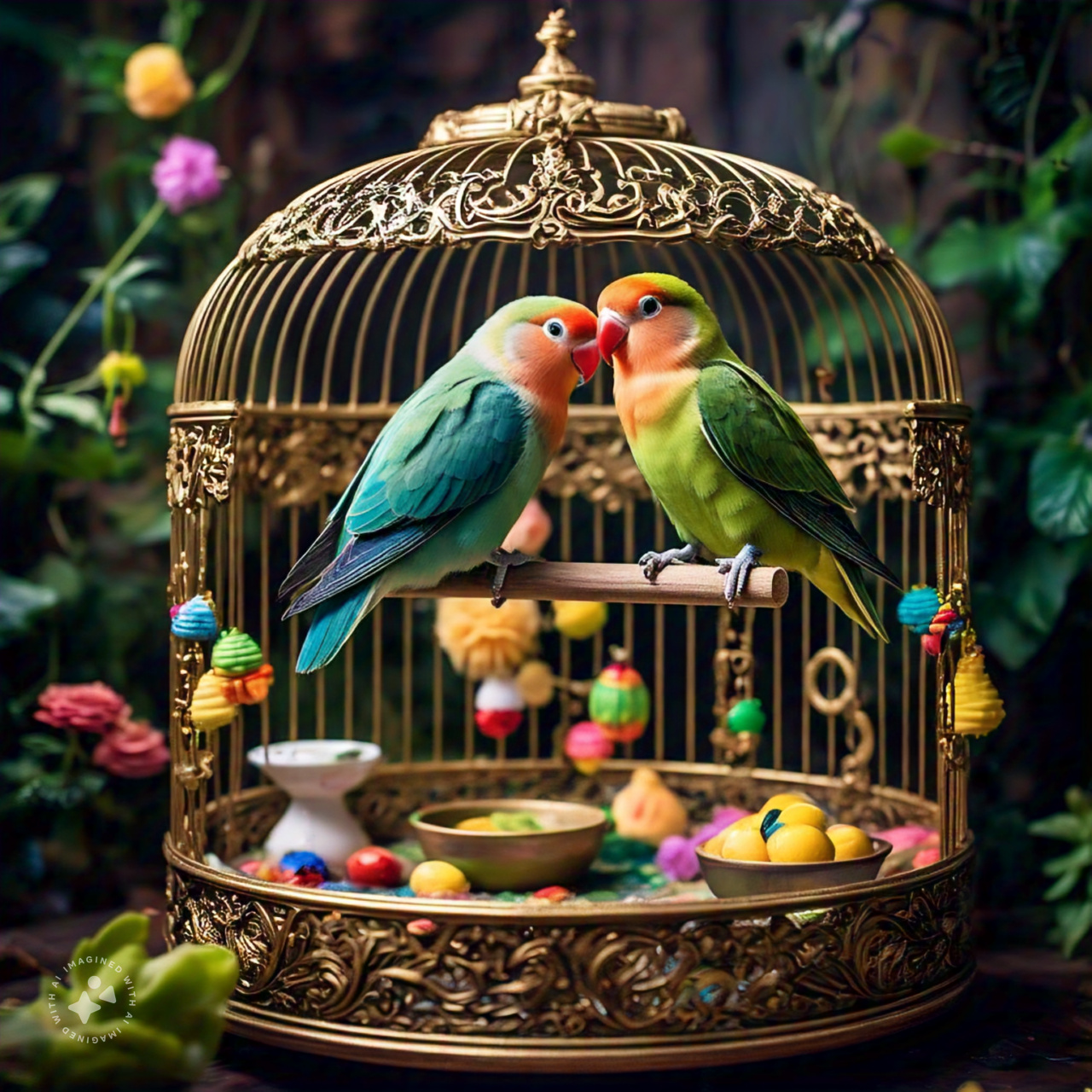Transform Your Lovebird’s Home: Expert Tips on Lovebird Cage Setup, Accessories, and Safety for a Perfect Perch Paradise!
Introduction
Are you ready to create the perfect home for your lovebird? Transforming your feathered friend’s cage into a paradise of comfort, safety, and fun doesn’t have to be complicated. Whether you’re a seasoned bird owner or a first-time lovebird parent, customizing your pet’s living space with the right features will enhance their happiness and health. In this guide, we’ll explore expert tips on setting up the ideal Lovebird cage, choosing the best cage accessories, and ensuring their environment is as safe as it is enjoyable. From cage setup to bar spacing and accessories, we’ve got it all covered to help you create the perfect perch paradise for your lovebird!

Crafting the Perfect Lovebird Cage Setup: A Step-by-Step Guide
Setting up your lovebird’s home is the first step in ensuring their well-being and happiness. A proper Lovebird cage setup is crucial to give them the space they need for exercise, exploration, and relaxation. Here’s how to get started:
Choosing the Right Cage:
The foundation of any Lovebird cage setup begins with selecting the right cage. Opt for a spacious cage with a solid construction that can withstand your bird’s natural curiosity and energetic movements. A rectangular or square cage with horizontal bars is ideal, as lovebirds love to climb. The cage should be at least 24 inches wide, 18 inches deep, and 24 inches tall for a single lovebird. Larger is always better, especially if you plan to have more than one bird.
For more tips on choosing the perfect cage, check out Petco’s Bird Cages Guide.
Location of the Cage:
Place your lovebird’s cage in a calm, well-lit area but away from drafts, direct sunlight, and excessive noise. Lovebirds are social creatures and enjoy being part of family activities, so consider placing the cage in a room where they can interact with you but not be overwhelmed by constant activity.
Layout of the Cage:
When setting up the interior of the cage, make sure there’s a good balance between space and accessories. Avoid overcrowding the cage with too many toys or perches, as this can limit your bird’s movement. Instead, focus on creating a comfortable and stimulating environment. Hang toys at various heights and place food and water containers in easy-to-reach spots. You can also find more advice on cage setup from The Spruce Pets.
Choosing the Best Cage Accessories for Lovebirds to Keep Them Happy and Healthy
A key component of your Lovebird cage setup is the selection of cage accessories that keep your bird entertained and healthy. The best cage accessories for lovebirds should encourage exercise, mental stimulation, and overall well-being.
Toys and Enrichment:
Lovebirds are intelligent and playful, so it’s essential to provide them with a variety of toys. Choose toys that allow your lovebird to climb, swing, chew, and forage. Wooden chew toys are a favorite, as they help keep their beaks healthy while offering mental stimulation. You can also include mirror toys, bells, and hanging ladders to encourage physical exercise.
For ideas on safe toys for lovebirds, explore Birdtopia.
Food and Water Containers:
Proper feeding accessories are essential. Look for stainless steel or ceramic bowls that are easy to clean and won’t tip over easily. Place water and food containers at different levels of the cage to encourage your lovebird to move around. You can also install a water dispenser to maintain cleanliness and avoid contamination. Check out Drs. Foster & Smith’s bird supplies.
Nesting Materials:
Even if you’re not planning to breed your lovebird, it’s a good idea to provide nesting materials. Shredded paper or coconut fiber is perfect for lining the bottom of the cage and allowing your lovebird to create a comfy space.
Lovebird Cage Size Recommendations: Ensuring Space for Comfort and Play
When it comes to Lovebird cage size recommendations, bigger is always better! Providing adequate space for your lovebird ensures they have room to move, stretch, and explore. But how do you know if the cage is big enough? Let’s break it down:
Minimum Cage Size:
For a single lovebird, the minimum recommended cage size is 24 inches wide, 18 inches deep, and 24 inches tall. However, if you have more than one lovebird, the cage should be even larger—around 36 inches wide and 24 inches deep to give each bird ample space to fly, move, and interact with each other without feeling cramped.
For more guidance on choosing cage sizes, visit The Bird Channel.
Vertical vs. Horizontal Space:
Lovebirds love to climb, so a cage that offers vertical space is just as important as horizontal space. Look for a cage with multiple levels or platforms. The more space your lovebird has to fly and exercise, the happier they will be.
Flight and Exercise:
While the cage itself is important, allowing your lovebird to fly outside of the cage for exercise is crucial. A safe and enclosed space where your bird can stretch its wings will contribute significantly to its overall health.
Selecting Safe Materials for Lovebird Cages: Protecting Your Feathered Friend
Safety is paramount when it comes to your lovebird’s living environment. Selecting safe materials for lovebird cages is one of the most important decisions you’ll make when setting up their home. Here’s how to ensure you choose safe, non-toxic materials:
Avoid Toxic Coatings:
Many bird cages come with coatings that can be harmful to your lovebird. Avoid cages with painted or powder-coated finishes, as the chemicals used can be toxic if ingested. Opt for cages made from stainless steel or powder-coated steel with bird-safe finishes.
Learn more about bird-safe cage materials at Bird Cages 101.
Choosing Non-Toxic Toys:
When choosing accessories like toys or climbing structures, make sure they are made of bird-safe materials. Natural wood, untreated bamboo, and sisal rope are excellent choices. Avoid toys with plastic parts or painted surfaces, as they can contain harmful chemicals.
Cleaning Materials:
The cleaning materials you use for your lovebird’s cage are just as important as the cage itself. Choose non-toxic cleaning products and avoid harsh chemicals, as these can leave harmful residues inside the cage. Check out EcoBirdy for eco-friendly, bird-safe cleaning tips.
Mastering Lovebird Cage Bar Spacing and Ideal Perches for Ultimate Safety and Fun
The final touch to your perfect Lovebird cage setup is the bar spacing and perch placement. Both are crucial for the safety and comfort of your lovebird.
Bar Spacing for Safety:
When choosing a cage, make sure the bar spacing is not too wide. Lovebirds are small, and wide gaps between the bars can pose a risk of injury. The ideal Lovebird cage bar spacing is between ½ inch and ¾ inch. This spacing ensures that your bird won’t get stuck or escape while keeping them safe from injury. For more on the importance of bar spacing, visit Lovebird Care.
Perches for Comfort:
Perches are essential for your lovebird’s physical health. Avoid using only flat perches, as they can cause pressure sores on your bird’s feet. Instead, opt for a variety of perch sizes and shapes, such as natural wood branches, that encourage your lovebird to move and stretch. Perches made of safe materials like untreated wood or cement are ideal, as they provide the right texture for gripping and trimming their nails.
Positioning Perches:
Place perches at different heights and angles to encourage exercise. Ensure that perches are positioned away from food and water containers to allow your lovebird to move freely without obstacles.
Conclusion
Creating the perfect home for your lovebird requires careful attention to detail, from cage setup to accessories and safety. By following these expert tips, you’ll be able to craft a Lovebird cage setup that promotes happiness, health, and safety. Choosing the right cage size, selecting the best cage accessories, and ensuring proper bar spacing and perch placement will help you create an enriching and stimulating environment for your feathered friend. With the right preparation, your lovebird will enjoy a perfect perch paradise, where they can thrive and bring joy to your life for years to come!






